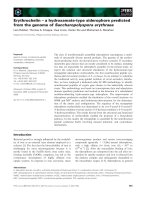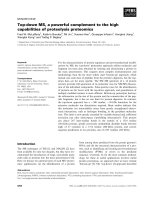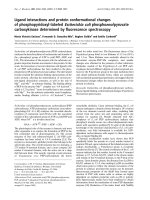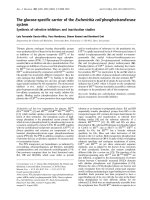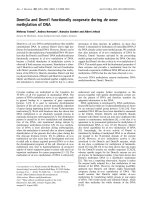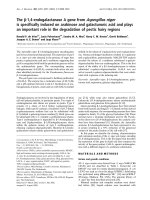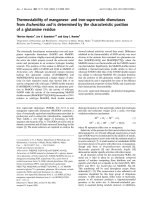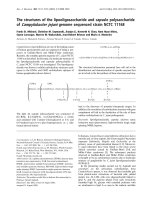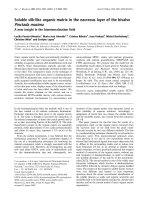Tài liệu Báo cáo Y học: Bivalent cations and amino-acid composition contribute to the thermostability of Bacillus licheniformis xylose isomerase doc
Bạn đang xem bản rút gọn của tài liệu. Xem và tải ngay bản đầy đủ của tài liệu tại đây (909.4 KB, 11 trang )
Bivalent cations and amino-acid composition contribute to the
thermostability of
Bacillus licheniformis
xylose isomerase
Claire Vieille
1
, Kevin L. Epting
2
, Robert M. Kelly
2
and J. Gregory Zeikus
1
1
Department of Biochemistry and Molecular Biology, Michigan State University, East Lansing, MI, USA;
2
Department of Chemical
Engineering, North Carolina State University, Raleigh, NC, USA
Comparative analysis of genome sequence data from
mesophilic and hyperthermophilic micro-organisms has
revealed a strong bias against specific thermolabile amino-
acid residues (i.e. N and Q) in hyperthermophilic proteins.
The N þ Q content of class II xylose isomerases (XIs)
from mesophiles, moderate thermophiles, and hyperther-
mophiles was examined. It was found to correlate
inversely with the growth temperature of the source
organism in all cases examined, except for the previously
uncharacterized XI from Bacillus licheniformis DSM13
(BLXI), which had an N þ Q content comparable to that
of homologs from much more thermophilic sources. To
determine whether BLXI behaves as a thermostable
enzyme, it was expressed in Escherichia coli, and the
thermostability and activity properties of the recombinant
enzyme were studied. Indeed, it was optimally active at
70–72 8C, which is significantly higher than the optimal
growth temperature (37 8C) of B. licheniformis. The
kinetic properties of BLXI, determined at 60 8C with
glucose and xylose as substrates, were comparable to
those of other class II XIs. The stability of BLXI was
dependent on the metallic cation present in its two
metal-binding sites. The enzyme thermostability
increased in the order apoenzyme , Mg
2þ
–enzyme ,
Co
2þ
–enzyme < Mn
2þ
–enzyme, with melting tempera-
tures of 50.3 8C, 53.3 8C, 73.4 8C, and 73.6 8C. BLXI
inactivation was first-order in all conditions examined. The
energy of activation for irreversible inactivation was also
strongly influenced by the metal present, ranging from
342 kJ·mol
21
(apoenzyme) to 604 kJ·mol
21
(Mg
2þ
–
enzyme) to 1166 kJ·mol
21
(Co
2þ
–enzyme). These results
suggest that the first irreversible event in BLXI unfolding is
the release of one or both of its metals from the active site.
Although N þ Q content was an indicator of thermo-
stability for class II XIs, this pattern may not hold for other
sets of homologous enzymes. In fact, the extremely
thermostable a-amylase from B. licheniformis was found
to have an average N þ Q content compared with
homologous enzymes from a variety of mesophilic and
thermophilic sources. Thus, it would appear that protein
thermostability is a function of more complex molecular
determinants than amino-acid content alone.
Keywords: Bacillus licheniformis; metal binding; thermo-
stability; xylose isomerase.
It has become apparent that protein thermostability arises
not from a single chemical or physical factor, but from
numerous subtle contributions integrated over the entire
molecular structure [1 – 6]. Thermostable proteins usually
exhibit no significant differences in backbone conformation
when compared with less thermostable proteins, but they
typically have increased numbers of salt bridges, side
chain–side chain hydrogen bonds, and residues involved in
a helices [7–9]. Stability at very high temperatures further
requires that a particular enzyme resist thermally induced
deleterious chemical reactions, which usually occur at
insignificant rates at lower temperatures [10]. For example,
one of the most evident patterns in the amino-acid
composition of hyperthermophilic proteins is the bias
against thermally labile amino-acid residues. This pattern is
obvious on examination of the amino-acid compositions of
the total protein content of eight mesophilic and seven
hyperthermophilic micro-organisms for which genome
sequence data are available (Table 1). The most striking
difference is the 55% reduction in the number of glutamines
in hyperthermophilic proteins; note also the 28% reduction
in asparagines. As these two amino acids are easily
deamidated at elevated temperatures [10– 13], it is not
surprising that they are less abundant in proteins from
hyperthermophiles. This observation raises the question of
whether a relatively low N þ Q content is a signature of
enhanced thermostability in proteins from mesophilic
sources.
The potential use of biocatalysts at high temperatures for
technological purposes has drawn interest in developing
thermoactive and thermostable enzymes that would provide
significant processing advantages [14]. For example,
thermostable xylose isomerases (XIs) (EC 5.3.1.5), which
catalyze the isomerization of
D-xylose to D-xylulose in vivo,
are used for the conversion of
D-glucose into D-fructose for
the production of high-fructose corn syrup [15]. Elevated
bioprocessing temperatures are preferred to achieve higher
catalytic rates as well as more favorable equilibrium yields
Correspondence to J. G. Zeikus, Department of Biochemistry and
Molecular Biology, 410 Biochemistry Building, Michigan State
University, East Lansing, MI 48824, USA. Fax: þ 517 353 9334,
Tel.: þ 517 353 5556, E-mail:
(Received 24 April 2001, revised 29 September 2001, accepted
10 October 2001)
Abbreviations: XI, xylose isomerase; BLXI, Bacillus licheniformis
xylose isomerase; DSC, differential scanning calorimetry.
Eur. J. Biochem. 268, 6291–6301 (2001) q FEBS 2001
Table 1. Amino-acid content of the total proteins of selected mesophiles and hyperthermophiles. Calculations were performed using all the open reading frames described in the genomic sequences present in
GenBank.
Organism Ala Cys Asp Glu Phe Gly His Ile Lys Leu Met Asn Pro Gln Arg Ser Thr Val Trp Tyr
Hyperthermophiles
Aquifex aeolicus 5.90 0.79 4.32 9.63 5.13 6.75 1.54 7.32 9.40 10.57 1.92 3.60 4.07 2.04 4.91 4.79 4.21 7.93 0.93 4.13
Archaeoglobus fulgidus
a
7.84 1.17 4.89 8.90 4.59 7.26 1.51 7.25 6.86 9.49 2.62 3.23 3.86 1.78 5.79 5.51 4.16 8.60 1.04 3.64
Aeropyrum pernix
a
9.53 0.93 3.88 6.61 2.75 8.55 1.92 5.19 3.52 11.38 1.97 2.04 6.46 1.90 7.71 7.53 4.69 8.75 1.31 3.36
Methanococcus jannaschii
a
5.54 1.27 5.52 8.67 4.20 6.41 1.43 10.45 10.36 9.38 2.33 5.24 3.38 1.44 3.85 4.46 4.06 6.85 0.71 4.33
Pyrococcus abyssi
b
6.68 0.55 4.61 8.85 4.35 7.26 1.50 8.50 7.80 10.25 2.40 3.34 4.26 1.67 5.73 4.97 4.20 8.07 1.18 3.83
Pyrococcus horikoshii
b
6.37 0.63 4.26 8.29 4.60 6.97 1.49 8.79 7.74 10.36 2.40 3.54 4.51 1.63 5.46 5.86 4.51 7.55 1.17 3.84
Thermotoga maritima 5.85 0.71 4.96 8.92 5.19 6.92 1.58 7.22 7.61 10.02 2.40 3.63 3.99 2.01 5.55 5.65 4.52 8.60 1.10 3.58
Average 6.82 0.86 4.63 8.55 4.40 7.16 1.57 7.82 7.61 10.21 2.29 3.52 4.36 1.78 5.57 5.54 4.34 8.05 1.06 3.82
Variance 1.72 0.06 0.25 0.77 0.57 0.4 0.02 2.31 4.02 0.4 0.06 0.75 0.84 0.04 1.15 0.88 0.05 0.4 0.03 0.09
Standard deviation 1.31 0.25 0.5 0.88 0.76 0.63 0.15 1.52 2.00 0.63 0.23 0.87 0.92 0.20 1.07 0.94 0.22 0.63 0.18 0.31
Mesophiles
Bacillus subtilis 7.69 0.80 5.18 7.24 4.49 6.91 2.28 7.36 7.05 9.64 2.78 3.95 3.68 3.84 4.13 6.31 5.43 6.75 1.03 3.47
Campylobacter jejuni 6.79 1.22 5.27 7.02 5.99 5.80 1.64 8.66 9.48 10.77 2.23 6.29 2.67 3.06 3.05 6.43 4.05 5.25 0.65 3.67
Escherichia coli 9.55 1.11 5.20 5.91 3.87 7.42 2.26 5.95 4.48 10.56 2.86 3.88 4.41 4.42 5.58 5.67 5.35 7.11 1.48 2.83
Haemophilus influenzae 8.21 1.03 4.98 6.48 4.46 6.65 2.05 7.10 6.32 10.50 2.44 4.89 3.72 4.64 4.47 5.84 5.20 6.68 1.12 3.12
Helicobacter pylori 6.83 1.09 4.77 6.88 5.41 5.76 2.12 7.20 8.94 11.18 2.28 5.83 3.28 3.70 3.46 6.81 4.37 5.59 0.7 3.68
Neisseria meningitidis 10.5 1.44 5.19 6.12 4.06 7.86 2.17 5.72 5.57 9.76 2.46 3.95 4.14 3.90 5.38 5.38 5.58 6.71 1.18 2.94
Rickettsia prowazekii 6.05 1.10 4.83 5.78 4.88 5.42 1.91 10.88 8.38 10.10 2.17 6.65 3.15 3.14 3.39 6.76 5.21 5.59 0.72 3.89
Synechosystis 9.07 1.01 5.07 6.20 3.75 7.77 1.93 6.31 4.26 10.93 2.12 3.76 5.09 5.26 5.18 5.46 5.53 7.10 1.30 2.78
Average 8.09 1.10 5.06 6.45 4.61 6.70 2.04 7.40 6.81 10.43 2.42 4.90 3.77 3.99 4.33 6.08 5.09 6.35 1.02 3.30
Variance 2.06 0.03 0.03 0.26 0.53 0.80 0.04 2.49 3.49 0.27 0.07 1.25 0.52 0.49 0.84 0.28 0.28 0.49 0.08 0.16
Standard deviation 1.44 0.17 0.17 0.51 0.73 0.89 0.20 1.58 1.87 0.52 0.26 1.12 0.72 0.70 0.92 0.53 0.53 0.70 0.29 0.40
t Distribution
Sigma 1.48 0.23 0.39 0.75 0.80 0.84 0.19 1.67 2.08 0.61 0.27 1.08 0.88 0.57 1.07 0.80 0.45 0.72 0.26 0.39
t 1.66 1.99 2.10 2 5.37 0.52 2 1.06 4.82 2 0.49 2 0.75 0.70 0.92 2.46 2 1.31 7.52 2 2.25 1.31 3.28 2 4.58 2 0.30 2 2.57
Confidence 5% x x x x x x x x
(t
0.975
¼ 2.16)
Confidence 1% x x x x
(t
0.995
¼ 3.01)
a
Archaea in which Gln-tRNA is formed through the activities of GatDE and GatCAB;
b
Archaea in which Gln-tRNA is formed only through the activity of GatDE [54].
6292 C. Vieille et al.(Eur. J. Biochem. 268) q FEBS 2001
[16]. Because of the commercial importance of XIs, their
biochemical, biophysical, and structural properties have
been extensively studied, and abundant sequence infor-
mation is available [10,17–24]. On the basis of the absence
or presence of a 50-residue insert at the N-terminus, XIs
have been classified into class I and class II enzymes,
respectively [25]. Two distinct metal-binding sites, M1 and
M2, have been identified in all XIs: (a) the metal in site M1
is co-ordinated to four carboxylate groups; (b) the metal in
site M2 is co-ordinated to one imidazole and three
carboxylate groups. The metals in sites M1 and M2 were
initially referred to as structural and catalytic metals,
respectively [18,26,27], but these appellations are no longer
valid, because later studies showed that both metals are
directly involved in catalysis [24,28,29]. The stabilizing and
activating metals are typically the bivalent cations Mg
2þ
,
Co
2þ
, and Mn
2þ
. Metal specificity depends on both the
nature of the substrate (i.e. glucose or xylose) and whether
the enzyme is a class I or class II XI. Thermus aquaticus XI,
a class I enzyme, isomerizes glucose most efficiently
when in the presence of Mn
2þ
, but its activity toward
xylose is highest with Co
2þ
as the cofactor [26]. The class II
Bacillus coagulans XI, on the other hand, isomerizes
xylose most efficiently when in the presence of Mn
2þ
,
whereas its activity toward fructose is best promoted by
Co
2þ
[27].
Class I XIs are a relatively homogeneous group when it
comes to thermostability, whereas class II XIs vary widely
in this regard. This heterogeneity among class II XIs may
arise from the existence of additional salt bridge(s) specific
to thermostable class II XIs [30]. In a previous study of class
II XIs, a positive correlation between the enzyme’s N þ Q
content and the growth temperature of the source organism
was observed: XIs from the most thermophilic sources
typically had lower N þ Q content [23]. Of the XIs
examined, only the enzyme from the mesophilic bacterium
Bacillus licheniformis DSM13 (BLXI) was atypical.
Originating from an organism that optimally grows at
37 8C, BLXI contains only 26 N þ Q residues, compared
with 23 in the enzyme from the hyperthermophile
Thermotoga neapolitana (optimal growth at 80 8C), and
46 in the XI from the mesophile Escherichia coli (optimal
growth at 37 8C). The low Q (and, to some extent, N)
content in proteins from hyperthermophiles (Table 1) raises
an interesting question: does a relatively low N þ Q content
in a protein from a mesophile indicate an unusually high
thermostability for this protein? The location of N and Q
residues within a protein structure is certainly a critical
consideration, but detailed structural information is often
not available to make this determination. In an attempt to
test the simple hypothesis that class II XI stability at high
temperatures correlates with its N þ Q content, independent
of the growth temperature of the source organism, the
biochemical and biophysical properties of the previously
uncharacterized BLXI were determined. Particular empha-
sis was placed on the influence of bivalent cations on activity
and stability. Our results show that for class II XIs, N þ Q
content relates to the enzyme’s functional temperature range
and that BLXI thermostability is also directly related to the
binding of specific metals as cofactors. At the same time, the
simple relationship between thermostability and N þ Q
content may not hold in general, as it is not the case for the
thermostable a-amylase from B. licheniformis.
MATERIALS AND METHODS
B. licheniformis xylA
gene cloning
B. licheniformis strain DSM13 was grown at 37 8Cin
Luria–Bertani broth [31]. A B. licheniformis genomic DNA
library was constructed in vector pUC18 (Pharmacia,
Piscataway, NJ, USA), using methods described in [23].
E. coli xyl
–
mutant HB101 (F
–
, hsdS20, ara-1, recA13,
proA12, lacY1, galK2, rpsL20, mtl-1, xyl-5 ) [32] was
transformed with the ligation mixture by electroporation and
plated on M9 medium containing 0.2% xylose, 0.1%
casamino acids, thiamine (500 mg·mL
21
), and ampicillin
(100 mg·mL
21
). Only the transformants expressing a
recombinant XI produced large colonies on this medium.
Enzyme purification
BLXI was purified from a 2-L culture of E. coli HB101
carrying plasmid pBL2 grown in M9 medium (comple-
mented as above). After centrifugation for 5 min at 4000 g,
the cell pellet was resuspended in 50 m
M Mops (pH 7.0)
containing 5 m
M MgSO
4
and 0.5 mM CoCl
2
(buffer A). The
cells were disrupted by two consecutive passes through a
French pressure cell (American Instrument Co., Silver
Spring, MD, USA), using a decrease in pressure of
96.5 MPa. After centrifugation at 25 000 g for 30 min, the
supernatant was heat-treated at 60 8C for 10 min. The
precipitated material was separated by centrifugation at
25 000 g for 30 min. The soluble fraction was loaded on to
a DEAE–Sepharose Fast-Flow column equilibrated with
buffer A. The protein was eluted with a linear 0.05– 0.4
M
NaCl gradient in buffer A. The active fractions were
analyzed by SDS/PAGE (12% acrylamide) and stained with
Coomassie blue R250. The homogeneous fractions were
pooled and extensively dialyzed against buffer A. Protein
concentrations were determined using the Bio-Rad protein
assay kit (Bio-Rad, Richmond, CA, USA), with BSA as the
standard. The purified enzyme was stored at 2 70 8C until
use.
Molecular mass determination
BLXI molecular mass was determined by gel filtration using
a Sephacryl S-300 HR column (1.4 cm £ 160 cm)
calibrated with blue dextran and protein standards of 443,
200, 150, and 66 kDa (Sigma Chemical Co., St Louis, MO,
USA). The flow rate was 0.2 mL·min
21
.
EDTA treatment
The purified enzyme was incubated overnight at 4 8Cin
buffer A containing 10 m
M EDTA. It was then dialyzed
twice against 50 m
M Mops (pH 7.0) (SigmaUltra, Sigma
Chemical Co.) containing 2 m
M EDTA, and finally dialyzed
twice against 50 m
M Mops (pH 7.0), this time without
EDTA. The apoenzyme was divided into aliquots and stored
at 2 70 8C until use.
Enzyme assays
BLXI activity was assayed routinely with glucose as the
substrate. The enzyme (0.06 mg·mL
21
) was incubated in
q FEBS 2001 B. licheniformis xylose isomerase (Eur. J. Biochem. 268) 6293
50 mM Mops (pH 7.0 at room temperature) containing
1m
M CoCl
2
and 1 M glucose at 60 8C for 20 min The
reaction was stopped by transferring the tubes to an ice bath.
The amount of fructose produced was determined by the
cysteine/carbazole/sulfuric acid method [33]. To determine
the effect of temperature on BLXI activity, the holo-BLXI
was incubated in the reaction mixture at the temperatures of
interest in a Perkin–Elmer Cetus GeneAmp PCR system
9600 (Perkin – Elmer, Norwalk, CT, USA) for 20 min. To
determine the kinetic parameters, assays were performed in
the presence of either 80–1400 m
M glucose or 20–900 mM
xylose. The amounts of fructose and xylulose produced were
determined using the cysteine/carbazole/sulfuric acid
method. Absorbance was measured at 537 nm and 560 nm
for xylulose and fructose, respectively. One unit of
isomerase activity is defined as the amount of enzyme that
produces 1 mmol of product per min under the assay
conditions.
Activation of apo-BLXI by metals
To examine the effect of bivalent cations on enzyme activity,
CoCl
2
, MnCl
2
, or MgCl
2
were added to the apoenzyme
reaction mixture at concentrations of 0.003– 100 m
M
(activity on glucose) or 0.002– 0.03 mM (activity on
xylose). Activity on xylose was determined using
0.024 mg·mL
21
apo-BLXI and 635 mM xylose. Activity
on glucose was determined using 0.06 mg·mL
21
apo-BLXI
and 1
M glucose. The activation constant, K
act
, for a metal is
defined as the metal concentration that results in 50% of
maximum activity [34,35].
Enzyme thermoinactivation
The apo-BLXI (0.17 mg·mL
21
)in50mM Mops (pH 7.0 at
room temperature) was incubated at various temperatures
(in a Perkin –Elmer Cetus GeneAmp PCR system 9600) for
different periods of time. Thermoinactivation was stopped
by transferring the tubes to an ice bath. Residual activity was
determined under the conditions described above, except
that the reaction mixture contained 5 m
M CoCl
2
instead of
1m
M CoCl
2
. To determine the effect of metals on the
apoenzyme stability, 0.5 m
M CoCl
2
, 0.5 mM MnCl
2
,or
2m
M MgCl
2
was added to the enzyme solution. The
resulting solution was equilibrated for 30 min at 30 8C
before thermoinactivation was initiated (preincubation
conditions known to be sufficient for the metal to reach
equilibrium between the buffer and enzyme metal-binding
sites [19]).
Heat-induced enzyme precipitation
Heat-induced enzyme precipitation was monitored from
25 8Cto908C by light scattering (l ¼ 580 nm), using the
apo-BLXI (0.08 mg·mL
21
)in10mM Mops (pH 7.0).
Absorbance measurements were conducted in 0.3-mL
quartz cuvettes (pathlength 1 cm) using a Beckman
DU-650 spectrophotometer equipped with a Peltier
cuvette-heating system. The increasing thermal gradient
was 1.0 8C·min
21
. The effect of metals on apo-BLXI
precipitation was studied in the presence of 0.5 m
M CoCl
2
,
0.5 m
M MnCl
2
,or5mM MgCl
2
.
PH studies
The effect of pH on BLXI activity was determined at 64 8C
using the routine assay described above, except that the
Mops buffer was substituted with 100 m
M sodium acetate
(pH 4.0–5.7), 100 m
M Pipes (pH 6.0–7.5), or 100 mM
Hepps (pH 7.5–8.7). All pHs were adjusted at room
temperature, and the DpK
a
/DT values for acetate, Pipes, and
Hepes (0.000, 2 0.0085, and 2 0.011, respectively) [36]
were taken into account for the results.
Differential scanning calorimetry (DSC)
DSC experiments were performed on a Nano-Cal differen-
tial scanning calorimeter (Calorimetry Sciences Corp.,
Provo, UT, USA) using a scan rate of 1 8C·min
21
. Samples
were scanned from 25 8C to 100 8C. The apoenzyme
(obtained by EDTA treatment, see above) was scanned
against 50 m
M Mops (pH 7.0). For the metal-containing
enzymes, the apoenzyme was incubated for 2 h at room
temperature with 5 m
M metal chloride. The enzyme solution
was then dialyzed once against 1 L 50 m
M Mops (pH 7.0)
to remove the metal that was not tightly bound to the
enzyme. Each metal-containing enzyme was scanned
against the corresponding dialysis buffer. The dialysis
buffer was used to generate the baseline. The enzyme
containing both Mg
2þ
and Co
2þ
was dialyzed against buffer
A, then scanned against the dialysis buffer as control.
RESULTS AND DISCUSSION
Cloning of the
B. licheniformis xylA
gene
Plasmid pBL1 was characterized from an HB101 transfor-
mant that formed large colonies on M9 medium containing
xylose. Comparison of the physical map of the plasmid
pBL1 insert with that of plasmid pWH1450 [37] indicated
Fig. 1. Determination of BLXI molecular mass by gel filtration.
V
e
/V
o
is the ratio of a protein’s elution volume to the elution volume of
blue dextran. (X) Protein standards; (A) BLXI. Linear regression (1),
with an r
2
of 0.951, is based on the elution data of all four protein
standards. Linear regression (2), with an r
2
of 0.981, is based on the
elution data of the 200, 150, and 66 kDa protein standards. Linear
regressions (1) and (2) give molecular masses of 200 and 177.5 kDa,
respectively, for BLXI.
6294 C. Vieille et al.(Eur. J. Biochem. 268) q FEBS 2001
that pBL1 contained B. licheniformis xylR, xylA, and a
truncated xylB. A 1.2-kb Sph I–Eco RI fragment was deleted
from the pBL1 insert to inactivate the B. licheniformis xylR
repressor gene, leading to plasmid pBL2. Plasmid pBL2 was
used to express BLXI in the rest of the study.
Purification of the recombinant protein and physical
properties
The B. licheniformis xylA gene was expressed from its own
promoter in plasmid pBL2. The recombinant enzyme was
purified (heat treatment plus DEAE–Sepharose chromato-
graphy) from an HB101 (pBL2) 2-L culture grown in M9
medium plus xylose. The purified enzyme was shown to be
homogeneous by SDS/PAGE and staining with Coomassie
blue. Approximately 100 mg enzyme was obtained from the
2-L culture. A molecular mass of 200 kDa for the native
protein was estimated by gel filtration (Fig. 1). Analysis by
SDS/PAGE showed a single band with a molecular mass of
about 50 kDa. This estimate is in agreement with that
expected from the protein sequence (50 905 Da). These
results indicate that BLXI is expressed as a homotetramer
in E. coli. It is interesting to note that XIs from the
thermophile Thermoanaerobacterium thermosulfurigenes
and the hyperthermophile T. neapolitana, both homotetra-
mers in their native forms, are expressed as active dimers
in E. coli [38].
Effects of temperature and pH on BLXI activity
The effect of temperature on BLXI activity was determined
by measuring the holoenzyme activity on glucose in the
presence of 1 m
M CoCl
2
. As shown in Fig. 2A, BLXI is
optimally active between 70 8C and 72 8C. Above 72 8C, the
enzyme rapidly loses activity, and it is completely inactive at
80 8C. The Arrhenius plot for BLXI activity is linear
between 35 8C and 66 8C. The estimated energy of
activation (E
a
) for BLXI activity is 76 kJ·mol
21
,anE
a
value comparable to those for E. coli and T. neapolitana XI
activities (70 and 80 kJ·mol
21
, respectively; unpublished
data).
The effect of pH on BLXI activity was determined by
measuring the holoenzyme activity on glucose between
pH 4.8 and 8.2 (values after temperature correction). BLXI
is optimally active at pH 7.2 and shows more than 80%
activity between pH 6.8 and 7.6 (Fig. 2B).
BLXI kinetic parameters
BLXI kinetic parameters were determined at 60 8C for
glucose and xylose using the holoenzyme in the presence of
1m
M CoCl
2
(Table 2). Not surprisingly, BLXI is about six
times more efficient on xylose than on glucose, as indicated
by the values of V
max
/K
m
. Compared with other type II
thermophilic XIs (Table 2), BLXI has average kinetic
parameters, but it has a relatively low catalytic efficiency on
xylose.
BLXI thermostability and inactivation characteristics
BLXI thermostability was first characterized using the
holoenzyme in the presence of 1 m
M CoCl
2
. In these
conditions, BLXI has a half-life of 14 h at 64 8C, 70 min at
67 8C, and 2 min 40 s at 70 8C. Figure 3 shows that BLXI
inactivation at 68 8C was first-order. Inactivation rates
obtained for three different enzyme concentrations at 68 8C
Table 2. Kinetic constants of thermophilic type II XIs.
Organism
T
(8C)
Glucose Xylose
Reference
V
max
(U·mg
21
)
K
m
(mM) V
max
/K
m
V
max
(U·mg
21
) V
max
/K
m
K
m
(mM)
B. licheniformis DSM13 60 7.7 145 0.053 22.2 67 0.33 This work
B. stearothermophilus 60 6.0 220 0.027 44.5 100 0.44 [55]
T. saccharolyticum B6A 65 6.3 120 0.053 17.6 16 1.10 [56]
T. thermosulfurigenes 4B 65 5.3 142 0.037 15.7 20 0.78 [56]
T. maritima DSM 3109 90 16.2 118 0.137 68.4 74 0.92 [57]
T. neapolitana 5068 90 22.4 89 0.253 52.2 16 3.28 [23]
Fig. 2. Effects of temperature and pH on BLXI
specific activity. (A) Arrhenius plot of BLXI
specific activity as a function of temperature. The
linear regression was only applied to the
temperature points below the optimum
temperature for activity. (B) Effect of pH on BLXI
activity. Assays were performed at 64 8Cin
100 m
M sodium acetate (A; pH 4.0– 5.7), 100 mM
Pipes (X; pH 6.0 –7.5), or 100 mM Hepes (K
pH 7.5 –8.7). The DpK
a
/DT values for acetate,
Pipes, and Hepps were taken into account to
calculate the pH values at 64 8C. All assays were
performed in triplicate.
q FEBS 2001 B. licheniformis xylose isomerase (Eur. J. Biochem. 268) 6295
(Fig. 3A; 0.012, 0.01, and 0.007 min
21
at 0.05, 0.5, and
2.5 mg·mL
21
enzyme, respectively) indicate that BLXI
inactivation is slightly dependent on concentration, with
BLXI stability increasing with enzyme concentration. At 0.5
and 2.5 mg·mL
21
, enzyme precipitation was noted during
BLXI inactivation. Residual activities were compared in
whole-enzyme (sample before centrifugation) and soluble
(supernatant after centrifugation) fractions after BLXI
inactivation at 68 8C. The soluble fraction showed an
inactivation rate that was slightly higher than the whole
enzyme (Fig. 3B). This difference does not appear to be
significant. Inactivation was accompanied by heavy
aggregation at this enzyme concentration, and the difference
in inactivation rate between the two samples probably
results from the trapping of some active soluble enzyme
molecules in the aggregate. As the aggregate increased in
size with inactivation time, more and more soluble enzyme
may remain trapped in the insoluble pellet during
centrifugation. These results suggest that the precipitated
enzyme was completely inactive, and that the soluble
fraction remained fully active. The Arrhenius plot of
BLXI inactivation rates was linear (not shown) with an E
a
of 908 kJ·mol
21
. This estimate is consistent with an
inactivation mechanism that involves significant unfolding
[10].
Metal requirement for BLXI activity
To determine which metal cation (Co
2þ
,Mn
2þ
,orMg
2þ
)
best activates BLXI on glucose and on xylose, the
apoenzyme activity was tested on both sugars in the
presence of increasing concentrations of each cation (in
the chloride form; Fig. 4). In the absence of metal, the
apoenzyme was completely inactive on both substrates.
Co
2þ
was by far the best activating cation for BLXI activity
on glucose. BLXI activity in the presence of Mn
2þ
and
Mg
2þ
reached only 6% and 15%, respectively, of the activity
in the presence of Co
2þ
(Fig. 4A). Co
2þ
,Mn
2þ
, and Mg
2þ
activation constants for BLXI activity on glucose are
approximately 0.5 m
M, 0.3 mM, and 4.5 mM, respectively.
The metal requirement of BLXI for activity on xylose was
significantly different from its metal requirement for activity
on glucose. The three metals studied stimulate BLXI
activity on xylose in the order Mn
2þ
$ Co
2þ
. Mg
2þ
(Figs 4B,C). Activity in the presence of Mg
2þ
was one-half
the activity in the presence of Mn
2þ
. K
act
values of Co
2þ
,
Mn
2þ
,andMg
2þ
forBLXIactivityonxyloseare
< 0.01 m
M, 0.0075 mM, and 0.2 mM, respectively, 22–50
times lower than for BLXI activity on glucose. Marg &
Clark [27] obtained a similar result with B. coagulans XI:
K
act
values were 10 times higher for glucose than for xylose,
and the relative effectiveness of the three metals was the
same. Occupancy rate of the M2 site necessary for activity
on glucose may be higher than that for activity on xylose; it
has been found that some XIs are active on xylose with only
the M1 site occupied [27]. Also, the metal-specific
Fig. 3. Characteristics of holo-BLXI inactivation at 68 8C. Assays
were performed in triplicate. All linear regression had correlation
coefficients r
2
above 0.96. (A) Effect of enzyme concentration on holo-
BLXI inactivation rate. Enzyme concentrations: (A) 0.05 mg·mL
21
;
(X) 0.5 mg·mL
21
;(K) 2.5 mg·mL
21
. Inactivation rates corresponding
to the slopes of the linear regressions for the three inactivation curves
were 0.012 min
21
at 0.05 mg·mL
21
, 0.01 min
21
at 0.5 mg·mL
21
, and
0.007 min
21
at 2.5 mg·mL
21
. (B) Remaining activity in the total and
soluble holo-BLXI fractions. Initial enzyme concentration was
2.5 mg·mL
21
. The soluble fraction corresponded to the supernatant
of the whole enzyme fraction, after centrifugation. (K) Whole enzyme;
(O) soluble fraction.
Fig. 4. Apo-BLXI activation by Co
21
(A), Mn
21
(X), and Mg
21
(S). (A) Apo-BLXI specific activity with glucose as the substrate. (B) and (C)
Apo-BLXI specific activity with xylose as the substrate. Assays were performed in triplicate.
6296 C. Vieille et al.(Eur. J. Biochem. 268) q FEBS 2001
differences observed in enzyme–metal binding are probably
related to differences between the metals with respect to
co-ordination geometries. These differences may influence
the metal preferences for glucose as opposed to xylose
isomerization. For example, whereas Mn–BLXI was highly
active on xylose, it was barely active on glucose.
Metal requirement of BLXI for stability
To determine the metal requirement of BLXI for
thermostability, the apoenzyme was incubated in the
presence of 0.5 m
M Co
2þ
, 0.5 mM Mn
2þ
,or2mM Mg
2þ
at different temperatures and for various periods of time.
The metal was allowed to equilibrate between the buffer and
the enzyme by preincubating the enzyme–metal mixture at
30 8C for 30 min. Remaining activity was measured with
glucose as the substrate in the presence of 4 m
M CoCl
2
. The
apoenzyme was significantly less stable than the enzyme
containing Co
2þ
,Mn
2þ
,orMg
2þ
(Fig. 5 and Table 3). Of
the three metal cations, Mn
2þ
stabilized BLXI best. Co
2þ
was only slightly less stabilizing than Mn
2þ
(Table 3).
Mg
2þ
was significantly less efficient than the other two
metals at stabilizing BLXI. This metal-specific protection of
BLXI against inactivation is very similar to the situation
observed with class I XIs: Mg
2þ
does not protect type I XIs
from unfolding to the extent that Co
2þ
does [39,40].
The E
a
values of BLXI inactivation were calculated for
the apoenzyme in the presence and absence of metals
(Table 3). The nature of the metal present clearly affected
the E
a
of BLXI inactivation. It was remarkably high in the
presence of Co
2þ
or Mn
2þ
, which explains why BLXI
specific activity decreased rapidly above 72 8C (Fig. 2). As
both the E
a
of inactivation and the temperature at which the
enzyme starts inactivating at a measurable rate increase
from the apoenzyme to the Mn
2þ
-containing enzyme, loss
of the metal cofactor could be the limiting step in BLXI
inactivation. Higher E
a
values of inactivation for the Co
2þ
–
enzyme and the Mn
2þ
–enzyme reflect the higher thermal
energy that these metal–enzyme complexes can accumulate
before losing the tightly bound metal, causing them to
unfold. The higher E
a
of inactivation provided by Co
2þ
and
Mn
2þ
compared with that provided by Mg
2þ
reflects the
different binding affinities of these cations for BLXI.
The extremely high E
a
of BLXI inactivation in the
presence of Co
2þ
or Mn
2þ
are interesting. With a similar
inactivation mechanism, E
a
of inactivation of T. thermo-
sulfurigenes XI is only 490 kJ·mol
21
in the presence of
Fig. 5. Arrhenius plots of apo-BLXI inactivation rates in the
absence (K) or presence of 0.5 m
M Co
21
(A), 0.5 mM Mn
21
(X), or
2m
M Mg
21
(S). All linear regression had correlation coefficients r
2
above 0.99.
Fig. 6. Determination of apo-BLXI precipitation temperature in
the presence of 2 m
M Mg
21
(S), 0.5 mM Co
21
(A), or 0.5 mM Mn
21
(X).
Table 3. Effect of metals on apo-BLXI stability. NI, Data not interpretable.
Metal
Kinetic stability
Thermodynamic stability:
Half-life
(min)
E
a
of
inactivation
(kJ·mol
21
)
Precipitation
temperature
(8C)
Melting
temperature
(8C)
No metal 24 (at 40 8C) 342 NI 50.3
2m
M MgCl
2
53 (at 54 8C) 604 57.1 53.3
35 (at 56 8C)
0.5 m
M CoCl
2
53 (at 69.5 8C) 1166 69.9 73.4
18 (at 70.5 8C)
0.5 m
M MnCl
2
50 (at 71.5 8C) 1073 72.8 73.6
16 (at 72.5 8C)
q FEBS 2001 B. licheniformis xylose isomerase (Eur. J. Biochem. 268) 6297
Co
2þ
(C. Vieille & J. G. Zeikus, unpublished results).
Structural information for BLXI in the presence of Mn
2þ
(or
Co
2þ
) and Mg
2þ
would provide insight into the molecular
determinants responsible for the differences in E
a
. The large
variation in E
a
of BLXI inactivation in the presence
of different metals suggests that the differences in E
a
of
inactivation for BLXI and T. thermosulfurigenes XI are
related to differences in metal co-ordination geometries.
Figure 6 and Table 3 show the effect of metals on BLXI
precipitation temperature. This temperature increased in the
order Mg
2þ
–BLXI , Co
2þ
–BLXI , Mn
2þ
–BLXI.
The precipitation temperatures in the presence of metals
correlate well with the inactivation data (Table 3).
Precipitation experiments with the apoenzyme did not
provide reproducible data (not shown).
The melting temperature for BLXI was determined by
DSC in the presence and absence of metals (Fig. 7 and
Table 3). It increased in the order apo-BLXI , Mg
2þ
–
BLXI , Co
2þ
–BLXI , Mn
2þ
–BLXI , (Mg
2þ
þ
Co
2þ
)–BLXI. These values are consistent with BLXI
inactivation and precipitation temperatures.
The lower stability and lower E
a
of inactivation of BLXI
in the presence of Mg
2þ
reflect the fact that the enzyme
binds Mg
2þ
with lower specificity (the K
act
of Mg
2þ
is 10
times higher that that of Co
2þ
or Mn
2þ
for both glucose and
xylose). However, the influence of pH on the decreased
protection of BLXI by Mg
2þ
against thermoinactivation
needs to be considered. The metals bind the enzyme through
one His imidazole and several carboxylate groups. By
affecting the carboxylate and His imidazole pK
a
values, pH
affects XI –metal binding. It has been shown that Mg
2þ
optimally binds XIs at pH values higher than either Co
2þ
or
Mn
2þ
[41]. Whereas Co
2þ
and Mn
2þ
are present in both
metal sites in crystals of Arthrobacter XI at pH 6.0, crystals
of Arthrobacter XI do not contain any Mg
2þ
at pH 6.0, and
contain Mg
2þ
only in site M1 at pH 8.0 [42]. As all
Fig. 7. Thermal unfolding of apo-BLXI in the presence and
absence of metals followed by DSC. See Materials and methods for
experimental details.
Fig. 8. Distribution of the N 1 Q (A), Q (B),
and N (C) contents in the 90 B. licheniformis
proteins of known sequence. Sequences were
obtained from GenBank.
6298 C. Vieille et al.(Eur. J. Biochem. 268) q FEBS 2001
inactivation experiments in this work were performed at
pH 7.0, Mg
2þ
binding was probably not optimal. The
difference in BLXI stabilization provided by Mg
2þ
v Co
2þ
or Mn
2þ
may be smaller if BLXI inactivation were tested at
a higher pH.
The significance of cation binding in XI stability has not
yet been examined closely. However, some information on
this issue is available. Site-directed mutagenesis has been
used to partially fill a metal-binding site with the side chain
of an amino acid. These mutations to both metal-binding
sites, M1 and M2, resulted in destabilized XIs. For example,
mutation of His220 in the class I S. rubiginosus XI affected
metal binding at M2, which in turn was responsible for
destabilization [35]. A similar observation has been made
for the class II E. coli XI: mutation of His271 (ligand to
metal 2) significantly destabilized the enzyme without
changing its structure appreciably (as determined by CD
analysis) [43]. Other point mutations triggering confor-
mational changes in active-site residues have also been
found to destabilize XIs [44], suggesting that thermal
unfolding starts through movements of active-site residues.
Metal cations probably act to lock the active site in a stable
conformation, which is lost as soon as the metal leaves the
active site. Specific differences in stabilization efficacy
between metals may be due to their ability to adopt different
geometries in the same site in the absence of substrate. In the
crystal structures of the S. rubiginosus enzyme, for
example, Co
2þ
in site 1 is tetra-co-ordinated or penta-co-
ordinated and it adopts a strongly distorted geometry
[45,46], whereas Mn
2þ
is hexa-co-ordinated and adopts an
octahedral geometry [18].
N 1 Q content as a general indicator of protein
thermostability in mesophiles
We reported previously [23] that the N þ Q content of class
II XIs correlated with the growth temperature of the source
organism, with the notable exception of BLXI. It is also
interesting that of the B. licheniformis proteins with
sequence available, the Q and N þ Q contents in BLXI
are among the lowest (Fig. 8A,B). This is not the case,
however, for the N content of BLXI (Fig. 8C). The entire
genome of several mesophilic and hyperthermophilic
organisms were analyzed in recent studies [9,47–49]. All
these studies reported a decrease in the content of uncharged
polar amino acids (i.e. Q, N, S, and T) and an increase in
charged amino-acid residues (i.e. K, E, and R) in
hyperthermophilic proteins. As S and T can catalyze the
deamination and backbone cleavage of Q and N residues
[48,50], a reduction in all four of these residues would
minimize deamination.
Although our prediction that BLXI, based on its low
N þ Q content, had thermophilic properties (i.e. high
thermostability and optimal activity at high temperatures)
proved to be correct, a high N þ Q content does not
necessarily predict that an enzyme will be thermolabile.
This observation is evident from Fig. 8: the B. licheniformis
a-amylase, which has an N þ Q content higher than the
average (4.88% N, 4.30% Q), is an extremely thermostable
enzyme, with optimal activity at 90 8C [51]. In addition, the
N and Q contents of B. licheniformis a-amylase are close to
the average N and Q contents (5.04 ^ 1.25% and
3.77 ^ 1.03%, respectively) of 20 homologous a-amylases
from micro-organisms with differing growth temperature
optima (data not shown). It is interesting to note, however,
that five out of the seven thermostabilizing mutations that
have been identified in this a-amylase (by Declerk et al.
[52,53]) are substitutions of N or Q residues by less
thermolabile amino acids. Thus, it appears that the N þ Q
content alone does not account for thermostability, and that
the location of these residues in the protein’s 3D structure
must be taken into account.
ACKNOWLEDGEMENTS
This work was supported by the US National Science Foundation,
grants NSF-Bes-9809964 (MSU) and NSF-Bes 9817067 (NCSU). We
express our deep gratitude to Dr A. Roy Day for his help with the
statistical analysis in Table 1 and Christopher B. Jambor for editing the
manuscript.
REFERENCES
1. Beadle, B.M., Baase, W.A., Wilson, D.B., Gilkes, N.R. & Shoichet,
B.K. (1999) Comparing the thermodynamic stabilities of a related
thermophilic and mesophilic enzyme. Biochemistry 38,
2570–2576.
2. Hollien, J. & Marqusee, S. (1999) Structural distribution of stability
in a thermophilic enzyme. Proc. Natl Acad. Sci. USA 96,
13674–13678.
3. Hasegawa, J., Uchiyama, S., Tanimoto, Y., Mizutani, M.,
Kobayashi, Y., Sambongi, Y. & Igarashi, Y. (2000) Selected
mutations in a mesophilic cytochrome c confer the stability of a
thermophilic counterpart. J. Biol. Chem. 275, 37824 –37828.
4. Numata, K., Hayashi-Iwasaki, Y., Kawaguchi, J., Sakurai, M.,
Moriyama, H., Tanaka, N. & Oshima, T. (2001) Thermostabiliza-
tion of a chimeric enzyme by residue substitutions: four amino acid
residues in loop regions are responsible for the thermostability of
Thermus thermophilus isopropylmalate dehydrogenase. Biochim.
Biophys. Acta 1545, 174 –183.
5. Petsko, G.A. (2001) Structural basis of thermostability in
hyperthermophilic proteins, or "there’s more than one way to
skin a cat". Methods Enzymol. 334, 469–478.
6. Vieille, C. & Zeikus, J.G. (2001) Hyperthermophilic enzymes:
sources, uses, and molecular mechanisms for thermostability.
Microbiol. Mol. Biol. Rev. 65, 1–43.
7. Adams, M.W. & Kelly, R.M. (1998) Finding and using
hyperthermophilic enzymes. Trends Biotechnol. 16, 329–332.
8. Elcock, A.H. (1998) The stability of salt bridges at high
temperatures: implications for hyperthermophilic proteins. J. Mol.
Biol. 284, 489 –502.
9. Cambillau, C. & Claverie, J M. (2000) Structural and genomic
correlates of hyperthermostability. J. Biol. Chem. 42,
32383–32386.
10. Hess, J.M. & Kelly, R.M. (1999) Influence of polymolecular events
on inactivation behavior of xylose isomerase from Thermotoga
neapolitana 5068. Biotechnol. Bioeng. 62, 509–517.
11. Ahern, T.J. & Klibanov, A.M. (1985) The mechanisms of
irreversible enzyme inactivation at 1008C. Science 228,
1280–1284.
12. Tomazic, S.J. & Klibanov, A.M. (1988) Mechanisms of irreversible
thermal inactivation of Bacillus a-amylases. J. Biol. Chem. 263,
3086–3091.
13. Tomazic, S.J. & Klibanov, A.M. (1988) Why is one Bacillus
a-amylase more resistant against irreversible thermoinactivation
than another? J. Biol. Chem. 263, 3092–3096.
14. Adams, M.W.W., Perler, F.B. & Kelly, R.M. (1995) Extremozymes:
expanding the limits of biocatalysis. Bio/Technol. 13, 662 –668.
15. Bentley, I.S. & Williams, E.C. (1996) Starch conversion. In
q FEBS 2001 B. licheniformis xylose isomerase (Eur. J. Biochem. 268) 6299
Industrial Enzymology (Godfrey, T. &West, S.I., eds), pp. 339–357.
Stockton Press, New York.
16. Converti, A. & Del Borghi, M. (1998) Kinetics of glucose
isomerization to fructose by immobilized glucose isomerase in the
presence of substrate protection. Bioprocess Engineering 18,
27–33.
17. Collyer, C.A. & Blow, D.M. (1990) Observations of reaction
intermediates and the mechanism of aldose-ketose interconversion
by
D-xylose isomerase. Proc. Natl Acad. Sci. USA 87, 1362 –1366.
18. Whitlow, M., Howard, A.J., Finzel, B.C., Poulos, T.L., Winborne,
E. & Gilliland, G.L. (1991) A metal-mediated hydride shift
mechanism for xylose isomerase based on the 1.6 A
˚
Streptomyces
rubiginosus structures with xylitol and
D-xylose. Proteins 9,
153–173.
19. van Bastelaere, P.B., Callens, M., Vangrysperre, W.A. & Kersters-
Hilderson, H.L. (1992) Binding characteristics of Mn
2þ
,Co
2þ
and
Mg
2þ
ions with several D-xylose isomerases. Biochem. J. 286,
729–735.
20. van Tilbeurgh, H., Jenkins, J., Chiadmi, M., Janin, J., Wodak, S.J.,
Mrabet, N.T. & Lambeir, A.M. (1992) Protein engineering of
xylose (glucose) isomerase from Actinoplanes missouriensis.3.
Changing metal specificity and the pH profile by site-directed
mutagenesis. Biochemistry 31, 5467–5471.
21. Meng, M., Bagdasarian, M. & Zeikus, J.G. (1993) Thermal
stabilization of xylose isomerase from Thermoanaerobacterium
thermosulfurigenes. Bio/Technol. 11, 1157–1161.
22. Lavie, A., Allen, K.N., Petsko, G.A. & Ringe, D. (1994) X-ray
crystallographic structures of
D-xylose isomerase-substrate com-
plexes position the substrate and provide evidence for metal
movement during catalysis. Biochemistry 33, 5469 –5480.
23. Vieille, C., Hess, J.M., Kelly, R.M. & Zeikus, J.G. (1995) xylA
cloning and sequencing and biochemical characterization of xylose
isomerase from Thermotoga neapolitana. Appl. Environ. Micro-
biol. 61, 1867–1875.
24. Bogumil, R., Kappl, R. & Hu
¨
ttermann, J. (2000) Role of the
binuclear manganese (II) site in xylose isomerase. In Metal Ions in
Biological Systems, vol. 37, pp. 366–405. Marcel Dekker, Inc.,
New York.
25. Vangrysperre, W., Van Damme, J., Vandekerckhove, J., De Bruyne,
C.K., Cornelis, R. & Kersters-Hilderson, H. (1990) Localization of
the essential histidine and carboxylate group in
D-xylose
isomerases. Biochem. J. 265, 699 –705.
26. Lehmacher, A. & Bisswanger, H. (1990) Comparative kinetics of
D-xylose and D-glucose isomerase activities of the D-xylose
isomerase from Thermus aquaticus HB8. Biol. Chem. Hoppe Seyler
371, 527 –536.
27. Marg, G.A. & Clark, D.S. (1990) Activation of the glucose
isomerase by divalent cations: evidence for two distinct metal-
binding sites. Enzyme Microb. Technol. 12, 367–373.
28. Jenkins, J., Janin, J., Rey, F., Chiadmi, M., van Tilbeurgh, H.,
Lasters, I., De Maeyer, M., Van Belle, D., Wodak, S.J., Lauwereys,
M., Stanssens, P., Mrabet, N.T., Snauwaert, J., Matthyssens, G. &
Lambeir, A M. (1992) Protein engineering of xylose (glucose)
isomerase from Actinoplanes missouriensis. 1. Crystallography and
site-directed mutagenesis of metal binding sites. Biochemistry 31,
5449–5458.
29. Allen, K.N., Lavie, A., Glasfeld, A., Tanada, T.N., Gerrity, D.P.,
Carlson, S.C., Farber, G.K., Petsko, G.A. & Ringe, D. (1994) Role
of the divalent metal ion in sugar binding, ring opening, and
isomerization by
D-xylose isomerase: replacement of a catalytic
metal by an amino acid. Biochemistry 33, 1488–1494.
30. Hartley, B.S., Hanlon, N., Jackson, R.J. & Rangarajan, M. (2000)
Glucose isomerase: insights into protein engineering for increased
thermostability. Biochim. Biophys. Acta 1543, 294–335.
31. Ausubel, F.M., Brent, R., Kingston, R.E., Moore, D.D., Seidman,
J.G., Smith, J.A. & Struhl, K., eds. (1993) Current Protocols in
Molecular Biology. Greene Publishing & Wiley-Interscience, New
York.
32. Boyer, H.W. & Roulland-Dussoix, D. (1969) A complementation
analysis of the restriction and modification of DNA in Escherichia
coli. J. Mol. Biol. 41, 459–472.
33. Dische, Z. & Borenfreund, E. (1951) A new spectrophotometric
method for the detection and determination of keto sugars and
trioses. J. Biol. Chem. 192, 583–587.
34. Lambeir, A.M., Lauwereys, M., Stanssens, P., Mrabet, N.T.,
Snauwaert, J., van Tilbeurgh, H., Matthyssens, G., Lasters, I., De
Maeyer, M., Wodak, S.J., Jenkins, J., Chiadmi, M. & Janin, J.
(1992) Protein engineering of xylose (glucose) isomerase from
Actinoplanes missouriensis. 2. Site-directed mutagenesis of the
xylose binding site. Biochemistry 31, 5459–5466.
35. Cha, J., Cho, Y., Whitaker, R.D., Carrell, H.L., Glusker, J.P.,
Karplus, P.A. & Batt, C.A. (1994) Perturbing the metal site in
D-xylose isomerase. Effect of mutations of His-220 on enzyme
stability. J. Biol. Chem. 269, 2687–2694.
36. Dawson, R.M., Elliott, D.C., Elliott, W.H. & Jones, K.M., eds.
(1986) Data for Biochemical Research, 3rd edn. Oxford University
Press, London.
37. Scheler, A., Rygus, T., Allmansberger, R. & Hillen, W. (1991)
Molecular cloning, structure, promoters and regulatory elements
for transcription of the Bacillus licheniformis encoded regulon for
xylose utilization. Arch. Microbiol. 155, 526–534.
38. Hess, J.M., Tchernajenko, V., Vieille, C., Zeikus, J.G. & Kelly,
R.M. (1998) Thermotoga neapolitana homotetrameric xylose
isomerase is expressed as a catalytically active and thermostable
dimer in Escherichia coli. Appl. Environ. Microbiol. 64,
2357–2360.
39. Callens, M., Tomme, P., Kersters-Hilderson, H., Cornelis, R.,
Vangrysperre, W. & De Bruyne, C.K. (1988) Metal ion binding to
D-xylose isomerase from Streptomyces violaceoruber. Biochem. J.
250, 285 –290.
40. Callens, M., Kersters-Hilderson, H., Vangrysperre, W. & De
Bruyne, C.K. (1988) D-xylose isomerase from Streptomyces
violaceoniger: structural and catalytic roles of bivalent metal ions.
Enzyme Microb. Technol. 10, 695–700.
41. van Bastelaere, P., Vangrysperre, W. & Kersters-Hilderson, H.
(1991) Kinetic studies of Mg(
2þ
)-, Co(
2þ
)- and Mn(
2þ
)-activated
D-xylose isomerases. Biochem. J. 278, 285 –292.
42. Collyer, C.A., Henrick, K. & Blow, D.M. (1990) Mechanism for
aldose-ketose interconversion by
D-xylose isomerase involving
ring opening followed by a 1,2-hydride shift. J. Mol. Biol. 212,
211–235.
43. Batt, C.A., Jamieson, A.C. & Vandeyar, M.A. (1990) Identification
of essential histidine residues in the active site of Escherichia coli
xylose (glucose) isomerase. Proc. Natl. Acad. Sci. USA 87,
618–622.
44. Varsani, L., Cui, T., Rangarajan, M., Hartley, B.S., Goldberg, J.,
Collyer, C. & Blow, D.M. (1993) Arthrobacter
D-xylose isomerase:
protein-engineered subunit interfaces. Biochem. J. 291, 575–583.
45. Sudfeldt, C., Schaffer, A., Kagi, J.H., Bogumil, R., Schulz, H.P.,
Wulff, S. & Witzel, H. (1990) Spectroscopic studies on the metal-
ion-binding sites of Co(
2þ
)-substituted D-xylose isomerase from
Streptomyces rubiginosus. Eur. J. Biochem. 193, 863–871.
46. Bogumil, R., Huttermann, J., Kappl, R., Stabler, R., Sudfeldt, C. &
Witzel, H. (1991) Visible, EPR and electron nuclear double-
resonance spectroscopic studies on the two metal-binding sites of
oxovanadium (IV)-substituted
D-xylose isomerase. Eur. J. Biochem.
196, 305 –312.
47. Haney, P.J., Stees, M. & Konisky, J. (1999) Analysis of thermal
stabilizing interactions in mesophilic and thermophilic adenylate
kinases from the genus Methanococcus. J. Biol. Chem. 274,
28453–28458.
48. Chakravarty, S. & Varadarajan, R. (2000) Elucidation of
6300 C. Vieille et al.(Eur. J. Biochem. 268) q FEBS 2001
determinants of protein stability through genome sequence
analysis. FEBS Lett. 470, 65 –69.
49. Szilagyi, A. & Zavodszky, P. (2000) Structural differences between
mesophilic, moderately thermophilic and extremely thermophilic
protein subunits: results of a comprehensive survey. Structure 8,
493–504.
50. Sterner, R. & Liebl, W. (2001) Thermophilic adaptation of proteins.
Crit Rev. Biochem. Mol. Biol. 36, 39–106.
51. Dong, G., Vieille, C., Savchenko, A. & Zeikus, J.G. (1997)
Cloning, sequencing, and expression of the gene encoding
extracellular a-amylase from Pyrococcus furiosus and biochemical
characterization of the recombinant enzyme. Appl. Environ.
Microbiol. 63, 3569 –3576.
52. Declerck, N., Joyet, P., Trosset, J.Y., Garnier, J. & Gaillardin, C.
(1995) Hyperthermostable mutants of Bacillus licheniformis
a-amylase: multiple amino acid replacements and molecular
modelling. Protein Eng. 8, 1029–1037.
53. Declerck, N., Machius, M., Wiegand, G., Huber, R. & Gaillardin, C.
(2000) Probing structural determinants specifying high thermo-
stability in Bacillus licheniformis a-amylase. J. Mol. Biol. 301,
1041–1057.
54. Tumbula, D.L., Becker, H.D., Chang, W Z. & So
¨
ll, D. (2000)
Domain-specific recruitment of amide amino acids for protein
synthesis. Nature (London) 407, 106–110.
55. Smith, C.A., Rangarajan, M. & Hartley, B.S. (1991) D-xylose
(
D-glucose) isomerase from Arthrobacter strain N.R.R.L. B3728.
Purification and properties. Biochem. J. 277, 255 –261.
56. Lee, C.Y. & Zeikus, J.G. (1991) Purification and characterization of
thermostable glucose isomerase from Clostridium thermosulfur-
ogenes and Thermoanaerobacter strain B6A. Biochem. J. 273,
565–571.
57. Brown, S.H., Sjøholm, C. & Kelly, R.M. (1993) Purification and
characterization of a highly thermostable glucose isomerase
produced by the extremely thermophilic eubacterium Thermotoga
maritima. Biotechnol. Bioeng. 41, 878–886.
q FEBS 2001 B. licheniformis xylose isomerase (Eur. J. Biochem. 268) 6301
